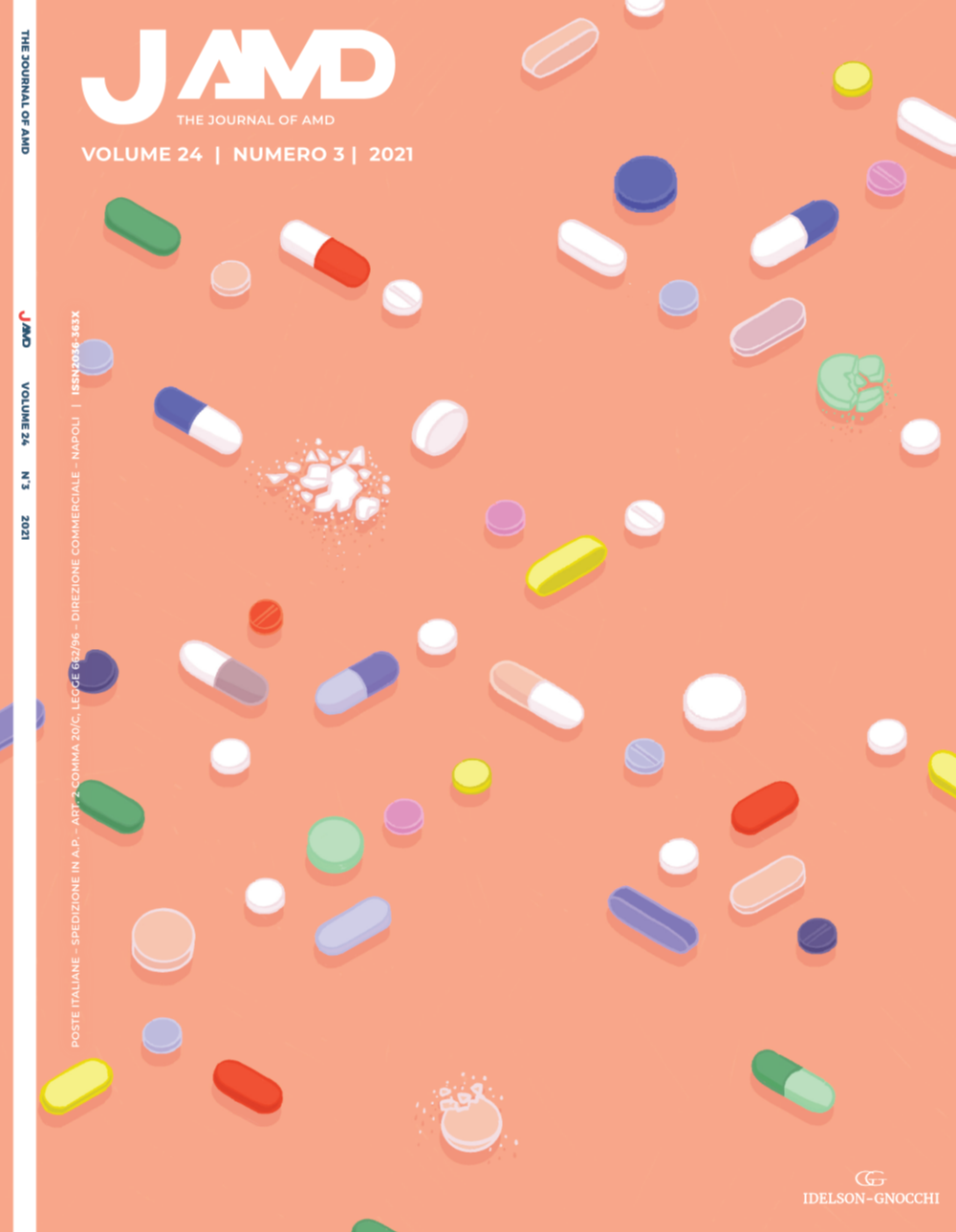Original articles
Cardiovascular ultrasound implementation for a pragmatic approach to the diabetic patient
JAMD 2021;24(3):178-183
The tailoring of the management of diabetes is the fundamental task of the diabetologist who requires very different skills to guarantee the best diagnostic path and the best treatment for patients. To enrich the range of “measures” necessary for this customization process, it is now possible to use a tool that is now accessible to everyone: the ultrasound machine. Through some simple ultrasound scans, using a minimum amount of time, it is possible to acquire useful information for correct patient stratification and for a rational therapeutic approach, as recommended by the guidelines.
The path for the certification of the skills of the diabetologist expert in the management of cardiovascular complications could be the natural context for the placement of these techniques.
KEYWORDS diabetes mellitus; cardiovascular complications; tailoring of therapy; echocolordoppler; echocardiography.
Esperienze di diabetologia clinica
Integration between general practice and hospital specialty for drug prescription appropriateness: the Diabetes Project of the Local Health Service Tuscany Centre
JAMD 2021;24(3):184-191
According to standards of medical care in diabetes, sulphonylureas and glinides are suggested to be abolished in the treatment of type 2 diabetes, due to their long-term adverse effects. In 2019, the Local Health Service – ASL Toscana Centro (TC) – promoted a collaboration among diabetologists, general practitioners (GPs) and pharmacists. In detail, the prescription of hypoglycemic drugs was retrieved through codes (ATCA10). After the presentation of the relative data and the recommendation/training of the diabetologist, the GPs were urged to abolish sulphonylureas and glinides, replacing them with newly generation drugs. Comparison with data in 2020 showed a significant drop in prescription of such drugs. Moreover, this project has allowed an estimate of the diabetic population within ASL TC additionally tracking other drugs, such as statins, which generally should be co-prescribed with hypoglycemic agents in the care of the diabetic patients.
In conclusion, this experience has increased the knowledge relating to the most recent standards of diabetic care in general practice, promoted the appropriateness in the use of newly drugs, generated epidemiological data, and helped in better planning the long-term pharmaceutical expenditure.
KEYWORDS general practice; educational training; stardards of care; sulphonylureas and glinides; statins.
Interdisciplinary joint clinical activity between Diabetologist and Orthopedic for the treatment of diabetic foot in the North West Tuscany
JAMD 2021;24(3):192-195
The diabetic foot can be treated only if you know how to work as a team and the diabetologist, the natural referent of the clinical case, has to create a multiprofessional/multidisciplinary team that can manage the patient to prevent injuries and treat them if they show up. The creation of structured diagnostic-therapeutic paths guarantees a better coordination of the professional figures involved, optimizes the management of the direct and indirect resources required to manage such a clinically challenging complication. After many years of activity we have built a solid integration between diabetologist and orthopedic, between hospital and territory and we have simplified a complex path. The fulcrum of this activity is the joint orthopaedic clinic that guarantees the correct care of the patient and allows the professional growth of the whole team.
KEYWORDS diabetic foot; integrated management; PDTA; team.
Reviews
Faster Aspart: a fast-acting insulin analog for an optimal glycemic control
JAMD 2021;24(3):196-205
The basal-bolus insulin regimen in the management of diabetes is essential to achieve the recommended glycosylated hemoglobin (HbA1c) to reduce the incidence or the progression of chronic complications. HbA1c is influenced by either fasting plasma glucose and post-prandial hyperglycemia. Faster Aspart is an insulin Aspart with two additional excipients, L-arginine and niacinamide, which provide a faster subcutaneous absorption, the earlier onset of appearance, and consequently the optimization of post-prandial glucose control. Faster Aspart has been widely investigated in the ‘‘onset’’ clinical trials, which show better post-prandial glycemic excursions and noninferiority compared to insulin Aspart with HbA1c reduction. Clinical evidence demonstrates that faster Aspart is a therapeutic option able to provide clinical benefits over the current rapid-acting insulin analogs in terms of improved meal-related glycaemic control in subjects with diabetes.
KEYWORDS post-prandial hyperglycemia; cardiovascular disease; insulin treatment; faster-acting insulin; faster aspart.
Diabetic neuropathy: the “anesthetized” complication
JAMD 2021;24(3):206-223
Diabetic peripheral neuropathy (DPN) is one of the most common complications of type 1 and type 2 diabetes. This microangiopathic complication is present in 50% of patients with more than 20 years of disease and approximately 18-30% of those who develop it produce painful neuropathy; it is present in 4%-18% of cases. The difficulty in the diagnosis of DPN is currently linked to the absence of a clinical-laboratory marker, such as microalbuminuria for nephropathy, and the need therefore for clinical evaluation by means of: history and objective examination analysed with a score; instrumental confirmation of the presence of fibre damage by studying the small and large nerve fibres. The clinical problem remains to diagnose as soon as possible: the absence of the complication; the presence of DPN in the dichotomous presentation of pain and anaesthesia, in most diabetic patients starting with those who have a longer duration of the disease. This would allow highlighting: patients at high ulcerative risk; those with the presence of important sensory-pain disorders to whom pain therapy should be best addressed.
The review will attempt to describe the most recent advances on DPN and therefore also of its diagnosis and its treatment, which starts with lifestyle modification, optimal metabolic control, achieved not too aggressively, intervention on other risk factors, and antioxidant therapy. A more precise and distinct sensory profile of patients with DPN and painful DPN may help to identify those who will respond to one treatment rather than another. Detailed sensory profiles will then lead to tailored treatment for subgroups of patients with painful DPN.
KEYWORDS neuropathy; diabetes; MNSI; MNDS; pain medications.
Case reports
Effectiveness of 10-kHz High-frequency spinal cord stimulation in diabetic polyneuropathy refractory to medical management: two case reports
JAMD 2021;24(3):224-229
The sensorimotor diabetic polyneuropathy represents a serious health problem, as it is responsible for an increased risk of mortality and substantial morbidity, resulting from foot ulceration, amputations, and impaired quality of life. Appropriate drug treatments are often unsuccessful at providing adequate pain relief and the use of minimally invasive procedures such as spinal cord stimulation (SCS) represents a valid therapeutic choice. Patient’s medical history and characteristics as well as clinical indication for the procedure influence the clinician in choosing the right type of therapy. Here we describe two cases suffering from type 2 diabetes mellitus and sensorimotor polyneuropathy, refractory to conventional medical management: in both cases, the 10-kHz high-frequency SCS therapy led to a long-term clinically meaningful relief of symptomatology which was evaluated in terms of: complete discharge of analgesic drugs, significant reduction in the intensity of perceived pain, recovery of motor function, improvement of mood tone and sleep quality.
KEYWORDS diabetic sensorimotor polyneuropathy; neuropathic pain; 10-kHz high-frequency spinal cord stimulation.
Documento congiunto SID-AMD
Type 2 diabetes mellitus therapy. Guideline by the Società Italiana di Diabetologia (SID) and the Associazione Medici Diabetologi (AMD). Methodology and synthesis
JAMD 2021;24(3):232-240
Type 2 diabetes mellitus therapy. Guideline by the Società Italiana di Diabetologia (SID) and the Associazione Medici Diabetologi (AMD). Evidence supporting the guideline
JAMD 2021;24(3):232-240
Punto di vista
Guidelines: EBM, implementation, professional responsibility
JAMD 2021;24(3):241-247
Documento congiunto SID-AMD
Le nuove linee guida sulla terapia del diabete di tipo 2. Una rivoluzione copernicana
New guidelines on type 2 diabetes therapy. A Copernican revolution
JAMD 2021;24(3):230-231




